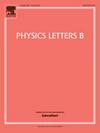高能前沿 CP-violation 的理论基础
IF 4.3
2区 物理与天体物理
Q1 ASTRONOMY & ASTROPHYSICS
引用次数: 0
摘要
我们在有效场论框架内,利用高维算子的 SMEFT 基础,对 TeV 尺度对撞机散射过程中的 CP-violation (CPV)搜索的发现潜力进行了总体分析。特别是,我们根据基础重理论的味道对称性,在一些动机明确的极限情况下系统地检验了 SMEFT 框架的 CP-violating 部门。我们证明,在底层新物理(NP)的自然性论证下,在没有(或抑制)改变味道的相互作用的情况下,只有一个改变顶优卡瓦耦合的算子 Qtj=j†j(q¯3t)j˜ 可以从树状级 SM×NP 干涉项产生非消失的违反 CP 效应。然而,我们发现,Qtj=j†j(q¯3t)j˜产生的CPV预计最多只有O(1%),因此,即使在大型强子对撞机或其他未来的高能对撞机上可以测量到,也是非常具有挑战性的。然后,我们得出结论:只有当底层 NP 中存在改变味道的相互作用时,高能散射过程中才可能出现 O(10%) 的可测量 CP 破坏效应;在这种情况下,树级的可观 CPV 可由纯粹的 NP×NP 效应而非 SM×NP 干涉产生。我们提供了几个大型强子对撞机和未来 e+e 对撞机上 CPV 的例子来支持这些说法。本文章由计算机程序翻译,如有差异,请以英文原文为准。
Theoretical underpinnings of CP-violation at the high-energy frontier
We present a general analysis for the discovery potential of CP-violation (CPV) searches in scattering processes at TeV-scale colliders in an effective field theory framework, using the SMEFT basis for higher dimensional operators. In particular, we systematically examine the CP-violating sector of the SMEFT framework in some well motivated limiting cases, based on flavour symmetries of the underlying heavy theory. We show that, under naturality arguments of the underlying new physics (NP) and in the absence of (or suppressed) flavour-changing interactions, there is only a single operator, which alters the top-Yukawa coupling, that can generate a non-vanishing CP-violating effect from tree-level SM×NP interference terms. We find, however, that CPV from is expected to be at best of and, therefore, very challenging if at all measurable at the LHC or other future high-energy colliders. We then conclude that a potentially measurable CP-violating effect of can arise in high-energy scattering processes only if flavour-changing interactions are present in the underlying NP; in this case a sizable CPV can be generated at the tree-level by pure NP×NP effects and not from SM×NP interference. We provide several examples of CPV at the LHC and at a future collider to support these statements.
求助全文
通过发布文献求助,成功后即可免费获取论文全文。
去求助
来源期刊

Physics Letters B
物理-物理:综合
CiteScore
9.10
自引率
6.80%
发文量
647
审稿时长
3 months
期刊介绍:
Physics Letters B ensures the rapid publication of important new results in particle physics, nuclear physics and cosmology. Specialized editors are responsible for contributions in experimental nuclear physics, theoretical nuclear physics, experimental high-energy physics, theoretical high-energy physics, and astrophysics.
 求助内容:
求助内容: 应助结果提醒方式:
应助结果提醒方式:


